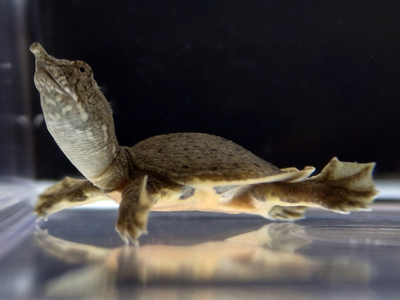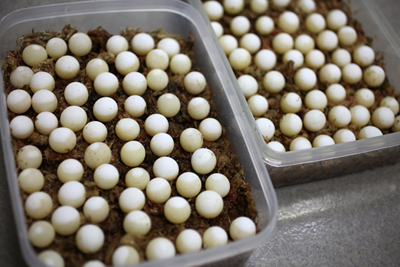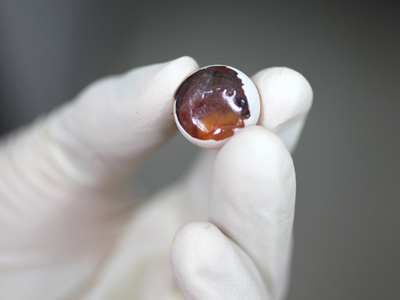Behind the Paper: Uncovering the Turtle Shell Mystery
Posted by Tatsuya Hirasawa, on 15 August 2013
 Turtles are firmly protected from predators by the unique bony shell. These animals are even capable to retract their head and limbs within the shell, thus their defense system seems to function perfectly. The turtle shell, in particular its dorsal part (carapace), is a strange structure, since it is contiguous with the ribs and vertebrae, unlike other armoured animals. How could such an invulnerable body plan ever evolve? Until recently, the mystery on the origin of the turtle shell has been invulnerable, as the protective nature of the shell itself.
Turtles are firmly protected from predators by the unique bony shell. These animals are even capable to retract their head and limbs within the shell, thus their defense system seems to function perfectly. The turtle shell, in particular its dorsal part (carapace), is a strange structure, since it is contiguous with the ribs and vertebrae, unlike other armoured animals. How could such an invulnerable body plan ever evolve? Until recently, the mystery on the origin of the turtle shell has been invulnerable, as the protective nature of the shell itself.
To uncover the above question, our laboratory has been systematically working on the embryonic development of the turtle shell. Fortunately in Japan, soft-shelled turtles are cultivated for diets by many farmers, and thus we picked up the Chinise soft-shelled turtle (Pelodiscus sinensis) as an item for the research.
In every summer, our laboratory purchases hundreds of turtle eggs from the farmer. The eggs are covered with hard, mineralized shells, just like chicken eggs. But, unlike the latter, the turtle egg requires sufficient moisture, otherwise they become dried out soon. We therefore put the eggs on a pile of fully moistened peat moss, and place them in an incubator adjusted at 30ºC, so that a high rate of survival can be expected. The eggshell of the turtle is semitransparent, and embryonic blood vessels and eyes are visible through the shell, enabling us to identify the developmental stage before sampling.
The turtle research team in our laboratory consists of only a few members (in 2013, three postdocs), but explores multilayerd subjects from genomes to fossils. We are currently investigating detailed histology, and gene expressions presumably responsible for the origin of the shell. Simultaneously we visit museum collections from time to time to examine fossil skeletons (unlike the other members of the lab, I majored in vertebrate paleontology). Through these investigations, we recently elucidated that the major part of the carapace is derived purely from endoskeletal ribs.
Discussion in the turtle team often provides us with new insights, or hunches, which would potentially help us drive our researches forward. This interaction is, I believe, a key to uncovering the evolutionary process of the turtle shell, in near future.
Hirasawa, T., H. Nagashima, and S. Kuratani. 2013. The endoskeletal origin of the turtle carapace. Nature Communications 4:2107 DOI: 10.1038/ncomms3107

Another recent paper from our laboratory:
Wang et al., 2013. The draft genomes of soft-shell turtle and green sea turtle yield insights into the development and evolution of the turtle-specific body plan. Nature Genetics 45:701-706 DOI: 10.1038/Ng.2615
Animations show origins of the turtle carapace (RIKEN CDB):
http://www.cdb.riken.jp/en/05_development/0506_turtle01.html




 (8 votes)
(8 votes)
Do these turtles have temperature-sensitive sex determination as is the case with other reptiles? And does this mean that the gender of all the turtles you research on is the same (since the eggs are all incubated at the same temperature- 30C)?
Thanks for your comment. That’s a good point, and I wondered the same thing when I participated in the turtle research team for the first time.
Actually, soft-shelled turtles have the genotypic sex-determining mechanism (ZZ/ZW type), unlike many other reptiles who have temperature-dependent sex-determining mechanism. So, it is expected that our embryos include both male and female individuals (though I have not checked the gender of each embryo/newborn).
Thank you for your answer! That is very interesting!
Is there a relation between the shell external organisation (the scale like structure) and the ribs positions ? Or they are completely unrelated mechanism ?
Hi
I found a few eggs from the beach that look exactly like chicken eggs… are all turtle eggs leathery or we get some brittle shells too??
Regards